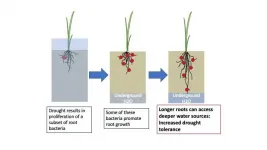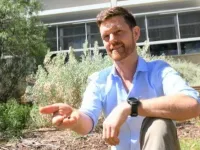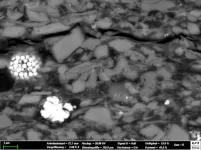(Press-News.org) Manipulating RNA can allow plants to yield dramatically more crops, as well as increasing drought tolerance, announced a group of scientists from the University of Chicago, Peking University and Guizhou University.
In initial tests, adding a gene encoding for a protein called FTO to both rice and potato plants increased their yield by 50% in field tests. The plants grew significantly larger, produced longer root systems and were better able to tolerate drought stress. Analysis also showed that the plants had increased their rate of photosynthesis.
"The change really is dramatic," said University of Chicago Prof. Chuan He, who together with Prof. Guifang Jia at Peking University, led the research. "What's more, it worked with almost every type of plant we tried it with so far, and it's a very simple modification to make."
The researchers are hopeful about the potential of this breakthrough, especially in the face of climate change and other pressures on crop systems worldwide.
"This really provides the possibility of engineering plants to potentially improve the ecosystem as global warming proceeds," said He, who is the John T. Wilson Distinguished Service Professor of Chemistry, Biochemistry and Molecular Biology. "We rely on plants for many, many things--everything from wood, food, and medicine, to flowers and oil--and this potentially offers a way to increase the stock material we can get from most plants."
Rice nudged along
For decades, scientists have been working to boost crop production in the face of an increasingly unstable climate and a growing global population. But such processes are usually complicated, and often result only in incremental changes.
The way this discovery came about was quite different.
Many of us remember RNA from high school biology, where we were taught that the RNA molecule reads DNA, then makes proteins to carry out tasks. But in 2011, He's lab opened an entire new field of research by discovering the keys to a different way that genes are expressed in mammals. It turns out that RNA doesn't simply read the DNA blueprint and carry it out blindly; the cell itself can also regulate which parts of the blueprint get expressed. It does so by placing chemical markers onto RNA to modulate which proteins are made and how many.
He and his colleagues immediately realized that this had major implications for biology. Since then, his team and others around the world have been trying to flesh out our understanding of the process and what it affects in animals, plants and different human diseases; for example, He is a co-founder of a biotech company now developing new anti-cancer medicines based on targeting RNA modification proteins.
He and Guifang Jia, a former UChicago postdoctoral researcher who is now an associate professor at Peking University, began to wonder how it affected plant biology.
They focused on a protein called FTO, the first known protein that erases chemical marks on RNA, which Jia found as a postdoctoral researcher in He's group at UChicago. The scientists knew it worked on RNA to affect cell growth in humans and other animals, so they tried inserting the gene for it into rice plants--and then watched in amazement as the plants took off.
"I think right then was when all of us realized we were doing something special," He said.
The rice plants grew three times more rice under laboratory conditions. When they tried it out in real field tests, the plants grew 50% more mass and yielded 50% more rice. They grew longer roots, photosynthesized more efficiently, and could better withstand stress from drought.
The scientists repeated the experiments with potato plants, which are part of a completely different family. The results were the same.
"That suggested a degree of universality that was extremely exciting," He said.
It took the scientists longer to begin to understand how this was happening. Further experiments showed that FTO started working early in the plant's development, boosting the total amount of biomass it produced.
The scientists think that FTO controls a process known as m6A, which is a key modification of RNA. In this scenario, FTO works by erasing m6A RNA to muffle some of the signals that tell plants to slow down and reduce growth. Imagine a road with lots of stoplights; if scientists cover up the red lights and leave the green, more and more cars can move along the road.
Overall, the modified plants produced significantly more RNA than control plants.
Modifying the process
The process described in this paper involves using an animal FTO gene in a plant. But once scientists fully understand this growth mechanism, He thinks there could be alternate ways to get the same effect.
"It seems that plants already have this layer of regulation, and all we did is tap into it," He said. "So the next step would be to discover how to do it using the plant's existing genetics."
He can imagine all sorts of uses down the road--and he's working with the university and the Polsky Center for Entrepreneurship and Innovation to explore the possibilities.
"Even beyond food, there are other consequences of climate change," said He. "Perhaps we could engineer grasses in threatened areas that can withstand drought. Perhaps we could teach a tree in the Midwest to grow longer roots, so that it's less likely to be toppled during strong storms. There are so many potential applications."
INFORMATION:
A new study showed that a wearable computer vision device can reduce collisions for both people who are blind or those who are visually impaired and using a long cane and/or guide dog by 37 percent, compared to using other mobility aids alone.
People who have visual impairments are at a significantly higher risk for collisions and falls. Commonly used mobility aids like long canes and guide dogs can offer benefits, but come with limitations in effectiveness and costs, respectively. While some electronic devices are marketed direct-to-consumer claiming to warn wearers of surrounding objects, there has been little evidence of their effectiveness in actual daily mobility settings. This is one of the first randomized-controlled trials to look at the potential benefit of the ...
What The Study Did: This study included 647 patients with untreated nonmetastatic prostate cancer (269 patients during the pandemic and 378 from before the pandemic). During the initial COVID-19 lockdown, only 1% of Black men underwent prostatectomy, while 26% of white patients did. Prior to the pandemic, there was no difference in the rate of prostatectomy between the two races (18% of Black men and 19% of white men). The lessons from this study suggest systemic inequities within health care and are likely applicable across medical specialties. Public health efforts are needed to fully recognize the unintended consequence of diversion of cancer resources to the COVID-19 pandemic to develop balanced mitigation strategies as viral rates continue to fluctuate.
Authors: ...
Drought can have a lasting impact on the community of microbes that live in and around roots of rice plants, a team led by UC Davis researchers has found. Root-associated microbes help plants take up nutrients from the soil, so the finding could help in understanding how rice responds to dry spells and how it can be made more resilient to drought. The work is published July 22 in Nature Plants.
The root microbiome of irrigated rice plants goes through a sequence of changes as the plants grow and stabilizes when they flower. The sequence of changes in the root ...
Restoration of degraded drylands is urgently needed to mitigate climate change, reverse desertification and secure livelihoods for the two billion people who live there, experts warn in a major new paper in Nature Ecology & Evolution.
Scientists leading the Global Arid Zone Project examined restoration seeding outcomes at 174 sites on six continents, encompassing 594,065 observations of 671 plant species - with the lessons learned important to meeting ambitious future restoration targets.
Flinders University Dr Martin Breed, one of three Australian researchers who helped coordinate ...
LONDON, 22 July 2021 - DeepMind today announced its partnership with the European Molecular Biology Laboratory (EMBL), Europe's flagship laboratory for the life sciences, to make the most complete and accurate database yet of predicted protein structure models for the human proteome. This will cover all ~20,000 proteins expressed by the human genome, and the data will be freely and openly available to the scientific community. The database and artificial intelligence system provide structural biologists with powerful new tools for examining a protein's three-dimensional structure, and offer a treasure trove of data that could unlock future advances and herald a new era for AI-enabled biology.
AlphaFold's recognition in December 2020 by the ...
Newly-hatched pterosaurs may have been able to fly but their flying abilities may have been different from adult pterosaurs, according to a new study.
Pterosaurs were a group of flying reptiles that lived during the Triassic, Jurassic and Cretaceous Periods (228 to 66 million years ago). Due to the rarity of fossilised pterosaur eggs and embryos, and difficulties distinguishing between hatchlings and small adults, it has been unclear whether newly-hatched pterosaurs were able to fly.
Researchers from the Universities of Portsmouth and Bristol, along with palaeontologist Darren Naish, found that hatchling humerus bones were stronger than those of many adult pterosaurs, indicating ...
The Alum Shale of Northern Europe not only has an eventful history of formation, connected with the microcontinent Baltica, it also holds great potential as an object of investigation for future research questions. Geologists use the rock to reconstruct processes of oil and gas formation, and even possible traces of past life on Mars can be identified with its help. Researchers at the German Research Centre for Geosciences Potsdam GFZ, together with colleagues from Canada, China, Switzerland and Denmark, have summarised the state of knowledge about the multi-layered rock. Their article was published in July in the journal Earth-Science Reviews.
The Microcontinent Baltica
"This rock tells a story," says Hans-Martin Schulz when he talks about the Northern European Alum Shale. It is ...
Astronomers using two of the world's most powerful radio telescopes have made a detailed and sensitive survey of a large segment of our home galaxy -- the Milky Way -- detecting previously unseen tracers of massive star formation, a process that dominates galactic ecosystems. The scientists combined the capabilities of the National Science Foundation's Karl G. Jansky Very Large Array (VLA) and the 100-meter Effelsberg Telescope in Germany to produce high-quality data that will serve researchers for years to come.
Stars with more than about ten times the mass of our Sun are important components of the Galaxy ...
Around 470 million years ago, plants began to conquer the terrestrial surfaces. The first examples had a small axis terminated by a structure capable of forming spores, almost like current mosses. The appearance of plant organs mediated the explosive radiation of land plants, which shaped the surface of our planet and allowed the establishment of terrestrial animal life.
However, evolving such a diversity of organs, such as roots, leaves, or immobile gametes, requires coordinated genetic changes: rise of new genes, repurpose of genetic material, and development of new regulatory programs. In a study published in Nature Plants, a consortium ...
A new study increases knowledge of the genetics behind aortic aneurysm, a disease that can spark life-threatening events like aortic dissections and ruptures.
University of Michigan Health-led researchers compared blood samples from more than 1,300 people who had a thoracic aortic aneurysm with more than 18,000 control samples, in partnership with U-M's Cardiovascular Health Improvement Project and its Michigan Genomics Initiative.
"After examining nearly the entire human genome for genetic changes that increase risk of aneurysm, we discovered a new change in the genetic code of a transcription factor, ...






